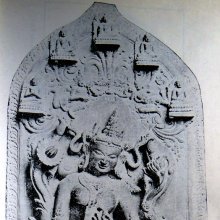Mahasri, Mahashri: 8 definitions
Introduction:
Mahasri means something in Buddhism, Pali, Hinduism, Sanskrit. If you want to know the exact meaning, history, etymology or English translation of this term then check out the descriptions on this page. Add your comment or reference to a book if you want to contribute to this summary article.
Images (photo gallery)
In Buddhism
Tibetan Buddhism (Vajrayana or tantric Buddhism)
Source: archive.org: The Indian Buddhist IconographyMahāśrī (महाश्री) or Mahāśrītārā (lit. “saviouress of great beauty”) refers to one of the various emanations of Amoghasiddhi, as mentioned in the 5th-century Sādhanamālā (a collection of sādhana texts that contain detailed instructions for rituals).—Her Colour: green; her Mudrā is the vyākhyāna; she has two arms and four companions.
The Dhyāna (meditation instructions) of Mahāśrī described in the Sādhanamālā as follows:—
“Mahāśrī Tārā sits on the seat of the moon, and is green in colour; she is endowed with two hands which exhibits the vyākhyāna-mudrā. She is one-faced and is adorned with ornaments. Two lotuses beautify her sides. She sits on a golden throne furnished with beautiful cushions. She is decked in a variety of flowers like the Aśoka, Campaka, Nāgeśvara and Pārijātaka. She bears on her crown a small figure of Amoghasiddhi.”
[Later, the sādhana gives a description of the four companion deities. Here Ekajaṭā who is stationed apparently to the left of the central deity, is of the following description:—“Ekajaṭā sits in the ardhaparyaṅka, is blue in colour, holds the kartri (knife ) and the kapāla (skull), and is angry-looking with a protruding belly. Her hair is of fiery red colour and matted, and she wears a garment made of tiger-skin”
In the corresponding right side appears Aśokakāntā who is described in the following words:—“Towards the right is Aśokakāntā who is yellow in colour, wears a crown of jewels, and carries the vajra and the Aśoka flower.”
The goddess Ārya-Jāṅgulī also appears on the further left, behind the figure of Ekajaṭā, and is described here as follows:—“Further to the left there is Ārya-Jāṅgulī of green colour showing in her hands the snake and the varada-mudrā.”
In the extreme right there is another goddess called Mahāmāyūrī. She is given the following form in the sādhana:—“In the right there is Mahāmāyūrī showing the peacock’s feathers and the varada-mudrā.”
The mantra of the central deity Mahāśrī Tārā is given in the Sādhana as: “Oṃ Tāre Tuttāre Ture dhanaṃ dade Svāhā”.—The mantra evidently makes her a goddess of wealth, and as such the deity must have been worshipped by the Tantric Buddhists, According to a further statement she sits in the rājalīlā-āsana or the pose of princely ease.]

Tibetan Buddhism includes schools such as Nyingma, Kadampa, Kagyu and Gelug. Their primary canon of literature is divided in two broad categories: The Kangyur, which consists of Buddha’s words, and the Tengyur, which includes commentaries from various sources. Esotericism and tantra techniques (vajrayāna) are collected indepently.
General definition (in Buddhism)
Source: The Art of Asia: Who is Who in HeavenMahasri (Japanese: Kichijoten):—“Goddess of Beauty”.
Languages of India and abroad
Sanskrit dictionary
Source: Cologne Digital Sanskrit Dictionaries: Shabda-Sagara Sanskrit-English DictionaryMahāśrī (महाश्री).—f.
(-śrīḥ) 1. A goddess peculiar to the Jainas. 2. An epithet of Lakshmi. E. mahā great, and śrī prosperity or the goddess.
Source: Cologne Digital Sanskrit Dictionaries: Benfey Sanskrit-English DictionaryMahāśrī (महाश्री).—f. epithet of Lakṣmī.
Mahāśrī is a Sanskrit compound consisting of the terms mahā and śrī (श्री).
Source: Cologne Digital Sanskrit Dictionaries: Monier-Williams Sanskrit-English Dictionary1) Mahāśrī (महाश्री):—[=mahā-śrī] [from mahā > mah] f. Name of Lakṣmī, [Horace H. Wilson]
2) [v.s. ...] of a Buddhist goddess, [cf. Lexicographers, esp. such as amarasiṃha, halāyudha, hemacandra, etc.]
Source: Cologne Digital Sanskrit Dictionaries: Yates Sanskrit-English DictionaryMahāśrī (महाश्री):—[mahā-śrī] (śrīḥ) 3. f. A goddess peculiar to the Jainas; Lakshmī.
[Sanskrit to German]
Sanskrit, also spelled संस्कृतम् (saṃskṛtam), is an ancient language of India commonly seen as the grandmother of the Indo-European language family (even English!). Closely allied with Prakrit and Pali, Sanskrit is more exhaustive in both grammar and terms and has the most extensive collection of literature in the world, greatly surpassing its sister-languages Greek and Latin.
See also (Relevant definitions)
Starts with: Mahashritara, Mahashriya.
Full-text: Kichijoten, Mahashritara, Varadatara, Varada.
Relevant text
Search found 6 books and stories containing Mahasri, Mahashri, Mahāśrī, Maha-sri, Mahā-śrī, Maha-shri; (plurals include: Mahasris, Mahashris, Mahāśrīs, sris, śrīs, shris). You can also click to the full overview containing English textual excerpts. Below are direct links for the most relevant articles:
The Indian Buddhist Iconography (by Benoytosh Bhattachacharyya)
Brihad Bhagavatamrita (commentary) (by Śrī Śrīmad Bhaktivedānta Nārāyana Gosvāmī Mahārāja)
Verse 2.4.173 < [Chapter 4 - Vaikuṇṭha (the spiritual world)]
Guhyagarbha Tantra (with Commentary) (by Gyurme Dorje)
Commentary 1-2: Teachings on the Wrathful Deities < [Chapter 15 (Text and Commentary)]
A Dictionary Of Chinese Buddhist Terms (by William Edward Soothill)
Bodhisattvacharyavatara (by Andreas Kretschmar)
Translator’s Introduction < [Introduction Text]
Buddhist records of the Western world (Xuanzang) (by Samuel Beal)
Chapter 1 - Country of Mo-kie-t’o (Magadha), part 1 < [Book VIII and IX]
